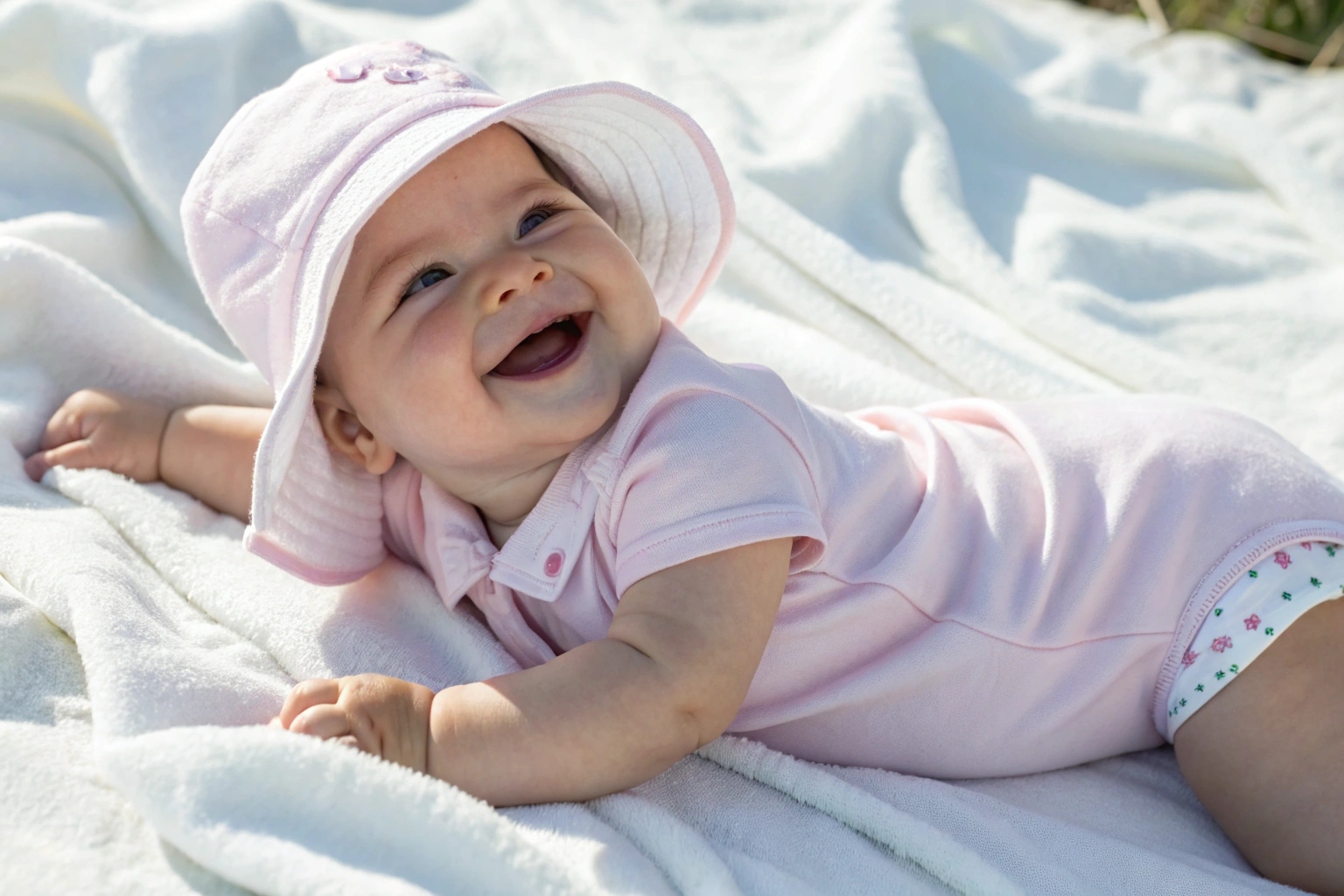New parents often make wardrobe decisions based on looks. But when it comes to babies, color isn’t just about style—it can impact their health.
Dark-colored clothes are not ideal for babies because they retain heat, may contain more chemical dyes, and can increase the risk of overheating, skin irritation, and discomfort. Lighter fabrics and colors are safer and more comfortable for infants.
While dark tones may seem stylish or stain-concealing, understanding how they affect a baby’s well-being can prevent unnecessary health concerns and discomfort.
Why Light Colors Are Safer for Infant Clothing?
Newborns can’t tell us when they’re uncomfortable. Their skin is thin, sensitive, and prone to irritation—and often, what they wear makes a difference.
Light-colored clothes are safer for infants because they reflect heat, reduce skin irritation from dyes, and signal cleanliness. These choices help protect your baby’s delicate skin and support better body temperature regulation.

How do chemical dye levels in dark-colored fabrics pose risks to a baby’s sensitive skin?
Dark fabrics are usually dyed with higher concentrations of chemical pigments to maintain color richness. For adult skin, this might not be a concern, but babies have far more permeable skin barriers. This means anything they wear can more easily interact with their skin.
Some dark colors—like deep blacks, navy blues, or rich reds—use synthetic dyes containing heavy metals or aromatic amines. These components can trigger rashes, eczema, or even allergic reactions. If the fabric isn’t properly washed or certified, the chemical residues left behind can linger.
By contrast, lighter colors typically require less dye concentration. Manufacturers don’t have to saturate the fabric with strong chemicals to get the desired hue. As a result, light-colored clothes are not only gentler but also easier to detect stains, dirt, or potential contaminants. For new parents, this means peace of mind and less worry about unseen irritants.
In what ways do light-colored garments help prevent overheating in infants?
Babies have underdeveloped thermoregulation systems. They can’t sweat efficiently, and their small bodies retain heat quickly. Dark clothes absorb sunlight and heat, while lighter ones reflect them.
A baby wrapped in dark clothing during a warm day can quickly become too warm. Signs like flushed cheeks, fussiness, or damp necks may appear—but by then, overheating has already begun. In some severe cases, overheating has been associated with increased risk of sudden infant death syndrome (SIDS).
On the other hand, soft pastel tones or white cotton reflect sunlight. The baby stays cooler, especially in warmer climates or indoor settings with poor airflow. Plus, light clothing pairs well with breathable fabrics like organic cotton or muslin, offering double protection.
As a parent and manufacturer at Fumao Clothing, I’ve seen this feedback countless times from clients across North America and Europe. Buyers switching to lighter-toned garments often report fewer returns and higher satisfaction from end customers. That’s not a coincidence.
Risks of Overheating in Babies Wearing Dark Clothes?
Even a minor increase in body temperature can make a baby cranky, sweaty, or worse—sick. Yet many parents still pick outfits based on trends, not temperature control.
Dark clothes absorb more heat from the environment, making babies more prone to overheating. Overheating can lead to dehydration, rashes, sleep disturbances, or serious conditions like SIDS in newborns.

How does color directly influence baby core temperature during daily wear?
Color plays a powerful role in heat absorption. Dark colors—particularly black, navy, or charcoal—absorb more infrared rays from both sunlight and artificial light. When those fabrics are in direct contact with a baby’s skin, they trap heat, preventing efficient temperature release.
Babies do not sweat like adults. Their bodies can’t cool down as fast, and their heads are often the only efficient way they release heat. If their clothing constantly feeds heat back into the skin, their core temperature rises slowly but steadily. Most parents won’t notice it until their baby is fussy, red-faced, or warm to the touch.
This can be especially problematic during outdoor trips, travel, or even naps under direct room lighting. If parents rely on dark onesies or rompers because they "hide stains better," they may unknowingly be contributing to thermal discomfort.
At Fumao Clothing, our factory tests color-heat absorption ratios on various infant apparel products. Our findings consistently show a 3–5°C surface temperature difference between black and pastel pink garments under the same lighting for 15 minutes.
What symptoms suggest a baby might be overheating from clothing?
Some of the early signs include:
| Symptom | Description |
|---|---|
| Flushed skin | Red cheeks or ears, especially during naps |
| Irritability | Fussiness not linked to hunger or diapers |
| Damp neck or back | Sweaty without exertion |
| Rapid breathing | Faster breaths without activity |
| Refusal to feed | Discomfort reducing appetite |
| Heat rash | Red, patchy areas especially under armpits or neck |
In extreme cases, prolonged overheating might even cause lethargy or vomiting. In cooler-colored, breathable clothes, babies show more consistent moods and feeding behaviors.
This isn’t theory—it’s what distributors from the US to Germany report to us consistently. Color and comfort go hand in hand.
Best Fabric and Color Choices for Newborn Outfits?
Every baby deserves clothing that’s soft, safe, and breathable. But the right fabric and color combination can do more than that—it can prevent skin conditions and boost daily comfort.
Soft, light-colored fabrics like organic cotton, bamboo, or muslin are best for newborns. They are breathable, chemical-free, and allow the baby’s skin to stay cool, dry, and irritation-free.

Why are natural fabrics and light tones a better combination for newborn care?
Newborns live in their clothes. They sleep in them, play in them, feed in them. So the material they’re wrapped in becomes their second skin. Natural fabrics like organic cotton and bamboo have microscopic breathable structures. They let air pass easily and wick away moisture.
Now pair those fabrics with pastel shades like cream, beige, baby blue, or mint. These colors reflect light and absorb less environmental heat. The fabric stays cooler and drier longer, reducing the risk of heat rash or bacterial growth.
Also, these lighter garments can be better indicators for hygiene. If a light onesie is dirty, you can spot it easily. With darker ones, spills or milk residue might blend in and stay longer, posing hygiene issues.
At Fumao Clothing, our production lines follow EU textile regulations strictly. Many buyers ask for GOTS-certified organic cotton in light tones because they’ve seen a clear reduction in customer complaints related to baby skin sensitivity.
How can wholesale buyers ensure consistent quality in baby clothing color and fabric?
It comes down to two things: supplier transparency and certification.
When sourcing from China, Vietnam, or India, ask your supplier:
- Do they provide fabric test reports?
- Are their dyes OEKO-TEX or GOTS compliant?
- Can they show colorfastness test results?
Here’s a sample checklist we provide to our buyers:
| Quality Control Item | What to Ask the Supplier |
|---|---|
| Fabric origin | Where is the cotton/bamboo sourced? |
| Dye certificate | OEKO-TEX or equivalent? |
| Colorfastness test | Level 4+ under ISO 105? |
| Shrinkage tolerance | Below 3% after washing? |
| Bulk vs sample match | Is the bulk production identical? |
We offer DDP delivery for hassle-free shipping, and our sales team is trained in English-language product specs—so there’s less room for confusion and delay.
How Clothing Color Affects Baby Comfort and Health?
Color does more than look good in photos. It shapes how your baby feels day-to-day—and how they grow into their early environment.
Clothing color affects infant comfort by regulating heat, signaling cleanliness, and reducing chances of allergic reactions. A well-chosen outfit improves not just comfort but also daily health stability.

How do colors influence daily baby mood and skin response?
Babies might not be able to describe their feelings, but they show it. Crying, squirming, sudden changes in skin tone—these are all physical cues. The clothes they wear can either calm or trigger these reactions.
For example, bright red or deep purple shades sometimes contain azo dyes. These can interact with moisture or sweat, causing mild irritation. In contrast, gentle colors like ivory, light lavender, or pale yellow promote visual calmness and rarely trigger skin issues.
I’ve spoken with many apparel brand owners in the U.S. and Europe who’ve run A/B tests on their baby lines. Time and time again, lighter colors receive better user feedback and generate higher reorder rates. Parents feel safer, and their babies are more settled.
What role does clothing color play in long-term baby skin care habits?
Starting early matters. If parents get used to dressing their babies in breathable, light-colored garments, they create a baseline of skin comfort and protection. Over time, that translates into fewer rashes, less dependence on creams or ointments, and more restful sleep.
Think of it like setting a foundation. Just like good food or clean water, safe clothing sets the stage for a healthy start. By contrast, poor choices in color or material lead to chronic skin sensitivity—and even future textile allergies.
At Fumao Clothing, our long-term buyers often integrate these insights into their marketing. It helps position their brand as thoughtful and baby-focused. We’re proud to help them build that credibility with clean fabrics, soft textures, and right-color choices.
Conclusion
Choosing baby clothes isn’t just about cuteness. Light-colored, breathable fabrics protect your baby from heat, chemicals, and discomfort. Choose wisely, and your baby—and your business—will thrive.










